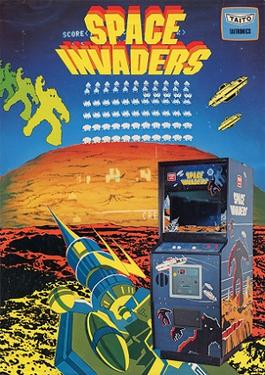
Space Invaders is a 1978 shoot 'em up arcade video game developed and published by Taito. It was released in Japan in April 1978, with the game being released by Midway Manufacturing overseas. Commonly considered to be one of the most influential video games of all time, Space Invaders was the first fixed shooter and the first video game with endless gameplay and set the template for the genre. The goal is to defeat wave after wave of descending aliens with a horizontally moving laser cannon to earn as many points as possible.
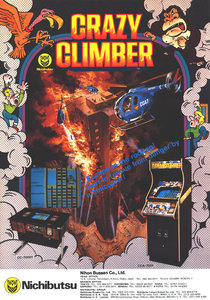
Crazy Climber is a vertically scrolling video game produced by Nichibutsu and released for arcades in 1980. In North America, the game was also released by Taito America. Ports for the Arcadia 2001 and Atari 2600 were published in 1982, followed by the Famicom in 1986 and X68000 in 1993.

Zaxxon is a scrolling shooter developed and released by Sega as an arcade video game in 1982. The player pilots a ship through heavily defended space fortresses. Japanese electronics company Ikegami Tsushinki was also involved in the game's development.

Radar Scope is a 1980 shoot 'em up arcade game developed by Nintendo R&D2 and published by Nintendo. The player assumes the role of the Sonic Spaceport starship and must wipe out formations of an enemy race known as the Gamma Raiders before they destroy the player's space station. Gameplay is similar to Space Invaders and Galaxian, but viewed from a three-dimensional third-person perspective.
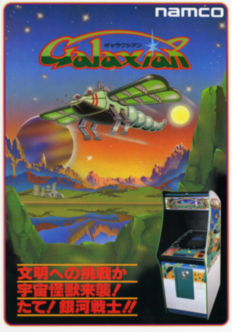
Galaxian is a 1979 fixed shooter arcade video game developed and published by Namco. The player assumes control of the Galaxip starfighter in its mission to protect Earth from waves of aliens. Gameplay involves destroying each formation of aliens, who dive down towards the player in an attempt to hit them.

Popeye is a 1982 platform game developed and released by Nintendo as an arcade video game. It is based on the comic strip of the same name created by E. C. Segar and licensed from King Features Syndicate. Some sources claim that Ikegami Tsushinki did programming work on the game. As Popeye, the player must collect hearts thrown by Olive Oyl from the top of the screen while being chased by Bluto. Popeye can punch bottles thrown at him, but can only hurt Bluto after eating the one can of spinach present in each level. Unlike Nintendo's earlier Donkey Kong games, there is no jump button. There are three screens.
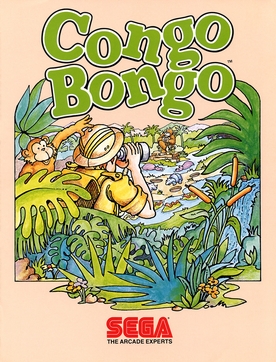
Congo Bongo, also known as Tip Top, is a platform game released as an arcade video game by Sega in 1983. A message in the ROM indicates it was coded at least in part by the company Ikegami Tsushinki. The game is viewed in an isometric perspective, like Sega's earlier Zaxxon (1982), but does not scroll. Numerous home ports followed.
Ikegami Tsushinki Co., Ltd. is a Japanese manufacturer of professional and broadcast television equipment, especially professional video cameras, both for electronic news gathering and studio use. The company was founded in 1946.

The Legend of Kage is a side-scrolling hack-and-slash game developed and published by Taito in 1985. In this game, the player controls the ninja Kage, with the objective being to get through five stages in order to save the princess Kirihime. These stages are littered with enemies, but Kage has various skills and weapons on his hands in order to get through them.

The Color TV-Game is the first video game system ever made by Nintendo. The system was released as a series of five dedicated home video game consoles between 1977 and 1983 in Japan only. Nintendo sold three million units of the first four models: one million units of each of the first two models, Color TV-Game 6 and 15; and half a million units of each of the next two models, Block Breaker and Racing 112. The Color TV-Game series has the highest sales figures of all the first generation of video game consoles.
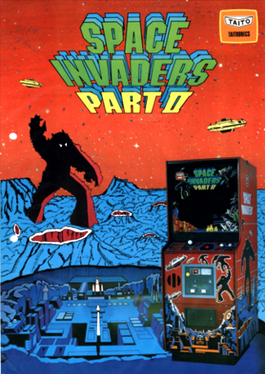
Space Invaders Part II is a 1979 fixed shooter arcade video game developed and published by Taito. In North America, it was distributed by Midway Games as Space Invaders Deluxe. It is the sequel to Space Invaders (1978). The player controls a laser base that must destroy formations of descending aliens, while avoiding their projectiles. New features have been added, such as aliens that split into two when shot, an increased high score limit with the player able to save their name as initials, and short cutscenes in-between stages. It runs on the Taito 8080 arcade system.
Ozma Wars is a fixed shooter arcade video game developed by Shin Nihon Kikaku (SNK) and released in 1979. The moving starfield background gives the impression of vertical scrolling, but the player ship's movement is restricted to the bottom of the screen.
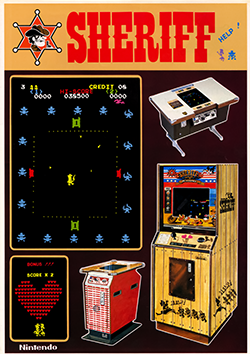
Sheriff, also known as Bandido, is a 1979 multi-directional shooter arcade game by Nintendo. It is one of several Western-themed video games from the 1970s, along with Western Gun, Outlaw, and Boot Hill. The player controls a county sheriff tasked with defense of a town against bandits, to rescue the captured woman. It was a commercial success in Japan, where it was among the top ten highest-grossing arcade games of 1979.

Exerion is a fixed shooter video game developed and published by Jaleco for arcades in September 1983, and licensed to Taito for manufacture and distribution of the game in North America. The player controls a starship and must fire at enemies on the screen while avoiding projectiles. The game uses a pseudo-3D scrolling background, giving a sense of depth, and the player's ship has a sense of inertia while it is being controlled with the joystick.
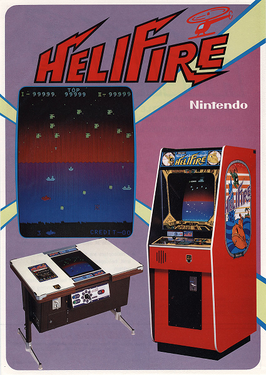
Heli Fire is a video game developed by Nintendo, and released in arcades in September 1980 by Nintendo. Some sources claim that Ikegami Tsushinki also did design work on Heli Fire. Similar to Taito's Polaris (1980), players control a submarine and must survive as long as possible against a barrage of enemy attacks from the sea and above.

Space Firebird is a 1980 arcade video game developed by Nintendo R&D1 and released by Nintendo in Japan and Europe. In America, the game was distributed by Far East Video. Sega-Gremlin also released a version of the game in North America.
Fitter, known as Round-Up in the Americas, is a maze-strategy arcade video game released by Taito in 1981. The game was released as Fitter, in Japan in October 1981 and in Europe the same year. Another Japanese company, Hiraoka, licensed a version called Round-Up to Centuri for release in the Americas in December 1981.

Heiankyo Alien, known as Digger in North America, is a maze video game created by The University of Tokyo's Theoretical Science Group (TSG) in 1979. The game was originally developed and released as a personal computer game in 1979, and was then published by Denki Onkyō Corporation as an arcade game in November 1979. In 1980, the arcade game was released in North America as Digger by Sega-Gremlin, with minor changes in appearance.
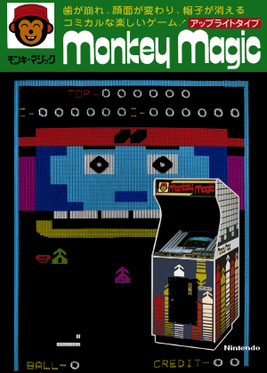
Monkey Magic (1979) is a video game released in arcades by Nintendo in exclusively in Japan in 1979. It is a Breakout clone and one of Nintendo's earliest arcade games. Some sources claim that Ikegami Tsushinki also did design work on Monkey Magic. Players control a paddle to hit the ball at a large number of blocks shaping a monkey's face. To earn a victory the user must destroy the entire face of the monkey. Players can also earn different numbers of points by catching blocks that fall, as well as hitting the ball in different places.

Speed Race is a 1974 arcade racing video game developed and manufactured by Taito and released under the titles Racer and Wheels in North America by distributor Midway Manufacturing in 1975. Designed by Tomohiro Nishikado, the gameplay involves the player using the attached steering wheel to maneuver a car alongside a fast vertical scrolling road. The objective is to score points by driving past other cars without colliding with them; more points are awarded for driving faster. Players must do this under a 90-second time limit, which ends the game when it runs out. The gameplay concepts were adapted from two earlier driving electro-mechanical games: Kasco's Mini Drive (1958) and Taito's Super Road 7 (1970).

















